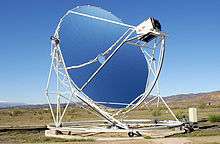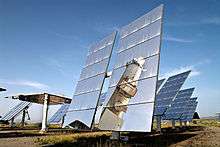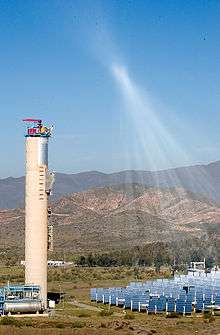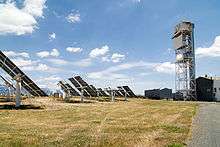Plataforma Solar de Almería


The Plataforma Solar de Almería (PSA) is a center for the exploration of the solar energy, situated in the Province of Almería, Spain in the Tabernas Desert.
History
The PSA was founded in the early 1980s and run by the Centro de Investigaciones Energéticas, Medioambientales y Tecnológicas (CIEMAT), a public research organization under the Spanish Ministry of Economy and Competitiveness.[1] PSA activities are integrated in the CIEMAT organization as an R&D division of the Department of Energy.
Testing
Over 20,000 m² of mirrors are installed on a 400,000 m2 (99-acre) site. There are several techniques tested under practical conditions, mainly solar thermal power plants. Hydrosol-2 is a solar power tower and a set of heliostats to collect the solar thermal energy.

About

- Facility belongs to CIEMAT, a public research organization under the Spanish Ministry of Economy and Competitiveness (MINECO).
- R&D activities focus on potential industrial applications of concentrating solar thermal energy and solar photochemistry.
- Built on a plot of 103 hectares located in Tabernas (Almería).
- About 120 staff, of which 40% are researchers.

Milestones
1975 The International Energy Agency (IEA) decided to design and build a facility in one location to validate the solar thermal technology potential for the production of electricity.
1976 A work group in the IEA proposed the development of two 500 kW thermosolar power plants (CRS y DCS) within the SSPS project.
1977 Spain through the Centro de Estudios de la Energía (CEE) started a study on a solar power plant of tower type of 1,2 MWe (Project CESA 1)
1978 The work of Basic Engineering for project CESA-1 started and it was decided to install the solar project in Tabernas, Almería.
1979 Begin of civil work for the construction of PSA
1981 Official inauguration of CRS and DCS plants of the Project SSPS
1983 Inauguration of the CESA-1 plant
1985 SSPS project finished and the activity undertaken here was replaced by SolarPACES activity that remains ongoing today
1986 Unification of the various facilities in the PSA, which was taken over by the Institute of Renewable Energy of CIEMAT.
1987 Signing of the Hispano-German Agreement with DLR for the co management of PSA
1990 Recognition as 'Large European Science Facility'
1998 The management of PSA is no longer based on the Hispano-German Agreement and the responsibility of the PSA is entirely Spanish
2005 The PSA is fully integrated into the CIEMAT structure, being a division of the Department of Energy
Research

Research activity at the Plataforma Solar de Almería has been structured around three R&D Units:
- Solar Concentrating Systems Unit.
- Solar Desalination Unit.
- Solar Treatment of Water Unit.
Test Facilities

- CESA-1 and SSPS-CRS central receiver systems, 5 and 2.5 MWth respectively.
- TCP-100 2.3-MWth parabolic-trough collector field with associated 115-m3 thermal oil storage system.
- DISS 2.5-MWth test loop, an excellent experimental system for two-phase flow and direct steam generation with parabolic trough collectors in different working conditions, up to 500 °C and 100bar.
- The FRESDEMO “linear Fresnel” technology loop.
- Pressurized gas cooled parabolic-trough collectors system coupled to two-tank molten salts thermal energy storage facility.
- A parabolic-trough collector test facility with thermal oil (the HTF-PTC Test loop) for qualification of solar components.
- A rotary test bench for parabolic trough collectors, named KONTAS.
- 4-unit dish/Stirling facility, named DISTAL, and 2 EuroDish units.
- A group of 3 solar furnaces, two of them with horizontal axis 60 kWth and 40 kWth, and a third one with vertical axis 5 kWth.
- A test stand for small evaluation and qualification of parabolic trough collectors, named CAPSOL.
- A 14-stage multi-effect distillation (MED) plant.
- A multiple solar detoxification and disinfection application facilities.
- The ARFRISOL building, an energy research demonstrator office building prototypes.
- A meteorological station integrated in the ‘Baseline Surface Radiation Network’.
See also
References
- La electricidad termosolar, historia de éxito de la investigación. Protermosolar, Sevilla, 2012. ISBN 978-84-614-0778-1
- Plataforma Solar de Almeria. Annual Report 2012. NIPO 721-13-016-4.
- Annual Technical Report 1994, Plataforma Solar de Almeria. ISBN 84-7834-283-4.
- Tecnología Energéticas e Impacto Ambiental. Macgraw-Hill/Interamericana, 2001. ISBN 84-481-3360-9
External links
Coordinates: 37°05′30″N 2°21′30″W / 37.0917°N 2.3583°W